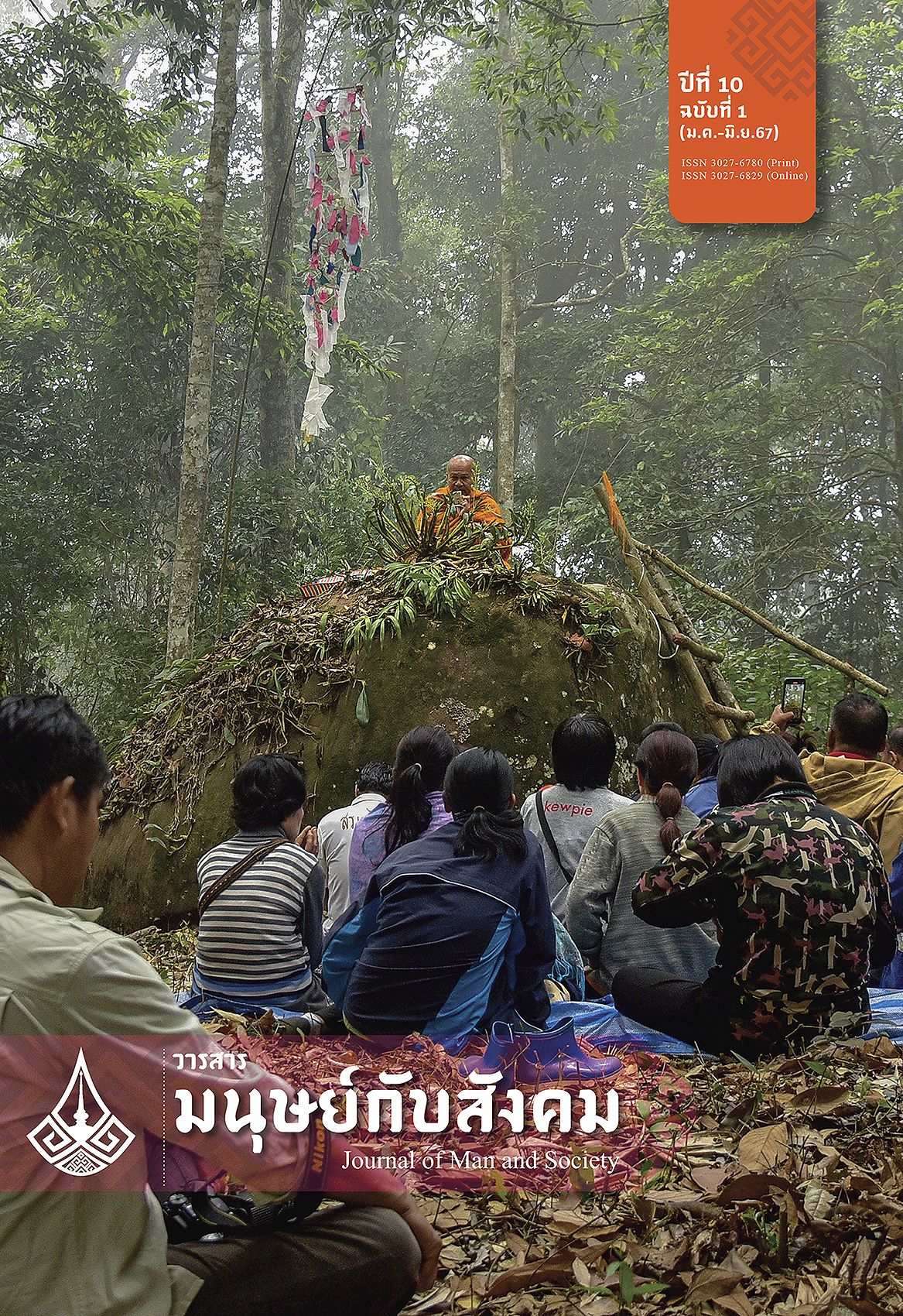Impact of Online Social Media Usage Behavior on Perceptions of Thai Polysemous Words among Chinese Students Studying Thai Language in Guangxi Zhuang Autonomous Region, China
Main Article Content
Abstract
The purpose of this research is to study the online social media usage behavior which affects on the perception of Thai polysemous words among Chinese students studying Thai language in the Greater China region, particularly in Guangzhou area by utilize the mixed method. Data was collected from 108 Chinese students at the undergraduate level, specifically in their third and fourth years. The research tools used for data collection were questionnaires. Statistics used for data analysis included mean and standard deviation, and statistics for hypothesis testing were one-way analysis of variance. The results indicate that the type of online social media that Chinese students mostly use is TikTok, and the predominant platform is Google’s website. In terms of online social media used for learning and developing Thai language skills is dramas, the majority of students spend 1 to less than 2 hours using these platforms. Regarding the frequency of using Thai platforms and Thai online social media per week, it was found that the majority of Chinese students do not use them. Yet, the media’s potential to convey stories about multiple words to Chinese learners is not yet fully available.The research indicates that factors related to ethnicity have no statistically significant impact on the frequency of using Thai platforms and watching online media. On the other hand, factors related to academic year have a statistically significant impact (<0.05) on the frequency of watching online social media. The usage behavior of online social media for learning and developing Thai language skills among Chinese students tends to involve more “consumption” rather than “active use”. Opinions about the behavior of using online social media which affects on the perception of Thai polysemous words are moderately in agreement. The topic that students mostly agree with is that regularly using online social media helps them become more familiar with Thai polysemous words. They also find examples of the use of multiple meanings in different sentences.
Article Details

This work is licensed under a Creative Commons Attribution-NonCommercial-NoDerivatives 4.0 International License.
เนื้อหาและข้อมูลที่ตีพิมพ์ลงในวารสารมนุษย์กับสังคม ถือเป็นข้อคิดเห็นและความรับผิดชอบโดยตรงของผู้เขียนซึ่งกองบรรณาธิการวารสารไม่จำเป็นต้องเห็นด้วยหรือร่วมรับผิดชอบใดๆ
บทความ ข้อมูล เนื้อหา รูปภาพ ฯลฯ ที่ได้รับการตีพิมพ์ในวารสารมนุษย์กับสังคม ถือเป็นลิขสิทธิ์ของวารสาร หากบุคคลหรือหน่วยงานใดต้องการนำทั้งหมดหรือส่วนหนึ่งส่วนใดไปเผยแพร่ต่อต้องอ้างอิงวาสาร
References
จรัสศรี จิรภาส. (2562). “ศึกษาไทย” และ “ไทยศึกษา” ในประเทศจีน. วารสารภาษาและวัฒนธรรม, 38(2), 94-118.
เฉิน ซงหลิง และ เพ็ญพิสุทธิ์ สีกาแก้ว. (2022, 1 มีนาคม). ยุทธศาสตร์ BRI กันนโยบายการพัฒนาบุคลากรผู้เชี่ยวชาญด้านภาษาไทยในประเทศจีน. Dhurakij Pundit University (DPU). https://www.dpu.ac.th/dpurdi/analysis/32.
ทรรศนีย์ คีรีศรี และ สมิหลา คีรีศรี. (2562). รายงานการวิจัยพฤติกรรมการใช้สื่อสังคมออนไลน์ในการพัฒนาทักษะภาษาอังกฤษของนักศึกษาระดับปริญญาตรี คณะศิลปศาสตร์ มหาวิทยาลัยเทคโนโลยีราชมงคลศรีวิชัยสงขลา. มหาวิทยาลัยเทคโนโลยีราชมงคลศรีวิชัย. https://www.repository.rmutsv.ac.th/bitstream/handle/123456789/3383/FullText.pdf?sequence=1&isAllowed=y
บุปผา เมฆศรีทองคำ และ ขจรจิต บุนนาค. (2556). รายงานการวิจัยฉบับสมบูรณ์ เรื่อง พฤติกรรมการบริโภคข่าวของคนต่างวัยในสังคมไทย. สภาการหนังสือพิมพ์แห่งชาติ สถาบันอิศรา และสำนักงานกองทุนสนับสนุนการสร้างเสริมสุขภาพ (สสส.). https://www.presscouncil.or.th/wp-content/uploads/2014/06/vijaibufpha1.pdf
รุ่งทิพย์ รัตนภานุศร และคณะ. (2549). การมีหลายความหมายของคำกริยา เห็น ในภาษาไทย. วารสารวิชาการมนุษยศาสตร์และสังคมศาสตร์, 4(1), 136-157.
รุ่งฤดี แผลงศร. (2554). การกำหนดคำศัพท์พื้นฐานภาษาไทยสำหรับผู้เรียนชาวต่างประเทศระดับต้น. วารสารมนุษยศาสตร์และสังคมศาสตร์, 2(2), 165-188.
โรสลีน่า สุมาลี. (2562). การใช้สื่อสังคมออนไลน์ของนักเรียนที่มีความสามารถด้านการพูดภาษาอังกฤษระดับสูงและปัจจัยที่ส่งเสริมความสามารถด้านการพูด. [วิทยานิพนธ์ปริญญาศิลปศาสตรมหาบัณฑิต ไม่ได้ตีพิมพ์]. มหาวิทยาลัยสงขลานครินทร์.
วศิน สุขสมบูรณ์วงศ์. (2563). การศึกษาความเข้าใจคำอุปลักษณ์รสชาติของอาหารในภาษาจีนของนักศึกษาสาขาวิชาภาษาจีน มหาวิทยาลัยราชภัฏพิบูลสงคราม. วารสารวิชาการคณะมนุษยศาสตร์และสังคมศาสตร์, 11(1), 61-73.
โสมรวี สมเพชร. (2563). การขยายความหมายของคําว่า “กัด” ในภาษาไทย: การศึกษาตามแนวอรรถศาสตร์ปริชาน. วารสารภาษาและวรรณคดีไทย, 37(2), 1-36.
อัมพร จิรัฐติกร และคณะ. (2562). รายงานวิจัยฉบับสมบูรณ์ โครงการการบริโภคละครโทรทัศน์ไทยผ่านเว็บไซด์ในกลุ่มประเทศอาเซียนและจีน: กรณีศึกษาประเทศเวียดนาม ฟิลิปปินส์ อินโดนีเซีย และจีน. สํานักงานคณะกรรมการส่งเสริมวิทยาศาสตร์ วิจัยและนวัตกรรม (สกว.). https://digital.library.tu.ac.th/tu_dc/frontend/Info/item/dc:165645#
Chen, F. (2011). The research on the spreading of Thai drama in China. [Unpublished master’s thesis]. Chongqing University.
Chen, Y. (2562). สภาพการเรียนภาษาไทยของนักศึกษาชาวจีน สาขาวิชาภาษาไทย ระดับปริญญาตรีในมหาวิทยาลัย ณ มณฑลยูนนาน สาธารณรัฐประชาชนจีน. [วิทยานิพนธ์ปริญญาศิลปศาสตรมหาบัณฑิต มหาวิทยาลัยศรีนครินทรวิโรฒ]. DSpace at Srinakharinwirot University. http://ir-ithesis.swu.ac.th/dspace/bitstream/123456789/465/1/gs581110011.pdf
Jirattikorn, A. (2023). Carnivalesque communities: Thai TV dramas and the Chinese censorship. INTER-ASIA CULTURAL STUDIES, 24(5), 776-792.
Sikakaew, P., Thamsatitsuk, K., Mo, L. F., Huang, X. C., & Chen, X. L. (2022). The tendency analysis of Thai language research in China during 2013-2020: A study on CNKI database. In DPU International Conference on Business, Innovation and Social Sciences 2022 (pp. 166-175). DOI Foundation. https://doi.org/10.29754/caicictbs.202205.0017.
Yamane, T. (1973). Statistics: An Introductory Analysis. Harper and Row Publications.


